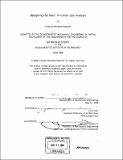| dc.contributor.advisor | Larry Sass. | en_US |
| dc.contributor.author | Roberts, Frances Omoleye | en_US |
| dc.contributor.other | Massachusetts Institute of Technology. Dept. of Mechanical Engineering. | en_US |
| dc.date.accessioned | 2007-03-12T17:46:24Z | |
| dc.date.available | 2007-03-12T17:46:24Z | |
| dc.date.copyright | 2006 | en_US |
| dc.date.issued | 2006 | en_US |
| dc.identifier.uri | http://hdl.handle.net/1721.1/36708 | |
| dc.description | Thesis (S.B.)--Massachusetts Institute of Technology, Dept. of Mechanical Engineering, 2006. | en_US |
| dc.description | Includes bibliographical references (leaf 26). | en_US |
| dc.description.abstract | Doors are essential objects that people use on a daily basis, however during the planning and design of buildings, they often appear to be overlooked from a human factors standpoint. The main functions of a door are to provide a way for people, animals, and objects to pass through an opening between and among outdoor and indoor spaces, regulating access in various ways and with consideration for several factors, including safety, energy loss, acoustics, and convenience. For the most part, we use doors giving little thought to their design or appearance. Bad door design, however, not only aggravates users but can lead to dangerous situations in the case of fire or emergencies. By identifying common problems with doors and entryways and determining workable design solutions to fix them, people can enjoy unencumbered flow from one space to another. In order to make designers more cognizant of human factors, building codes should be updated to reflect a more human-conscious approach to the design of doors and entryways. | en_US |
| dc.description.statementofresponsibility | by Frances Omoleye. | en_US |
| dc.format.extent | 26 leaves | en_US |
| dc.language.iso | eng | en_US |
| dc.publisher | Massachusetts Institute of Technology | en_US |
| dc.rights | M.I.T. theses are protected by copyright. They may be viewed from this source for any purpose, but reproduction or distribution in any format is prohibited without written permission. See provided URL for inquiries about permission. | en_US |
| dc.rights.uri | http://dspace.mit.edu/handle/1721.1/7582 | |
| dc.subject | Mechanical Engineering. | en_US |
| dc.title | Designing the door : a human use analysis | en_US |
| dc.type | Thesis | en_US |
| dc.description.degree | S.B. | en_US |
| dc.contributor.department | Massachusetts Institute of Technology. Department of Mechanical Engineering | |
| dc.identifier.oclc | 77553653 | en_US |
